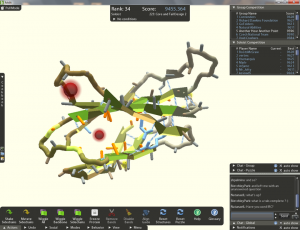Why do you stay up so late? is a poem written by Marvin Bell that utilizes digital media to enhance the reading experience by augmenting the literary elements. In the poem, Bell uses traditional elements such as theme, conflict (internal), style, tone, and figurative language; he uses colors, sounds, and animations to compliment his words and heighten the meaning in his work. The sounds set the somber tone of the poem before the author’s words have the opportunity to create it. The animation of a lit match on the first page reminds the reader that it is late at night and there is very little light to work by.
Additionally, the hand tapping a pencil on the table is a visual of the author’s restlessness in attempting to write. The tapping makes the reader feel just as restless as the author, allowing the reader to sympathize with the author’s internal conflict. Also the animations visually represent the figurative language the author uses.
When the author describes the young poets and then transitions back to himself, the animation mirrors the transition by shifting from many tapping pencils to one tapping pencil.
The lone tapping continues until he says “I am frozen in the white page.” It is at this moment that the animation freezes, highlighting his conflict and figurative language.
Additionally, colors are used to set the scene as well as accent specific words and lines. For most of the poem, the words are set on a black background. It all changes with the appearance of the word “light”. The word is the only brightness on a dark surrounding because it is meant to be a single source of light that appears “through the ice.” This is followed by the screen flashing, and the background shifting to white. Here the sound maintains its repetitive beat, but the tone changes. This change creates a sense of optimism, but reminds the reader that things are still the same. This sentiment is echoed when the screen returns to a black background and Bell writes “this is not the story.” The contrast with colors and word selection is used throughout the poem as Bell sometimes highlights certain words by using different colors.
The affect that producing the poem in this form has is emphasized when you look at the poem in its pure html form. Here the reader finds a 24 line poem that when read does not touch us emotionally like the animated version does. Also, the animated version requires the reader to spend more time on the poem than one may necessarily spend reading it because you can only transition pages when the author allows. By using electronic literature as his medium, Bell is able to utilize multiple tools to create what traditional authors attempt to do with one. He creates the readers’ environment through manipulation of sounds, colors and time while traditional authors can only use words. Though critics may argue the latter is more difficult and therefore more impressive, the former assures that the reader experiences the environment the author intends.
Looking at how this contributes to the electronic literature conversation, I turn to the questions presented by Katherine Hayles in Electronic Literature: New Horizons for the Literary (2008).
1) “Is electronic literature really literature?” (Hayles 2008)
This question is difficult to answer because it depends on your definition of literature. Hayles has a more inclusive definition of electronic literature that includes work that that provides the reader with an experience (or gives meaning to it) and is “digitally born” to be read electronically. Personally, it is too specific but at the same time too inclusive. If Hayles limits electronic literature to work created electronically, then she eliminates some the projects discussed in class. By her definition, projects created using code would be the only forms of electronic literature because that is the only way for something to be truly “digital born.” Would her definition exclude remediations? Implementation, for example, is in a remediation of a book. Since its origin in a print source, does it lose credibility? Or perhaps should it be considered experimental or some other form of literature.
To me, literature must use words in the form of a poem, play (scripts), or novel to create an experience. By this definition, Why do you stay up so late? would de defined as a type of literature. Bell’s poem uses words to create an experience. However, not all electronic literature falls under this category. For example, Arteroids is an ‘end of language piece’ that uses words to create meaning. However, the medium is a game, and the words are used more as a piece of art rather than a piece of literature.
As a result, I would alter Hayles’s definition to include remediation, but to exclude projects that are without words in the form of a poem, play, or novel.
2) “Will the dissemination mechanism of the internet and the Web, by opening publication to everyone, result in a flood of worthless drivel?” (Hayles 2008)
In short, yes. Based on the list that was discussed in class, there are numerous examples of “worthless” electronic literature. Nonetheless, I do not think this is a reason to prevent its development. In traditional literature, there are plenty of examples of literature that critics view as worthless, but that has not deterred writers. If poorly written books did not end traditional literature, then a few poorly created projects should not end electronic literature. Furthermore, the presence of mediocre literature, electronic and traditional alike, creates a contrast by which ‘valuable’ literature can appear even better.
3) Can traditional literature coexist with electronic literature?
This question parallels the discussion we had earlier in the semester on whether E-readers will eventually become more prominent than written novels. I think that in this scenario, both forms are invaluable so they should both continue. Unfortunately, because of the trajectory humanity has taken away from books and towards television and video media, electronic literature may be the only way to captivate future readers. Therefore, I think that electronic literature will become the primary source of literature, but I hope that future authors include non-augmented transcripts like Bell does.
All of the attributes I described involving how Why do you stay up so late? augmented the nature of the poem are not only why I feel that it is an effective use of electronic literature, but also the reason I like it. Bell effectively balances the electronic and traditional literature elements to create an aesthetically pleasing and well written poem. Nothing too abstract is done, and the electronic medium is used to achieve features that cannot be completed in different media. As electronic literature develops, I hope that it will be able to utilize improvements in technology to augment and improve the reading experience.
Works Cited:
Bell, Marvin, and Nikki Ruddy. Shakespeare’s Wages: Fifteen Poems. [S.l.]: Gendun Editions, 2004.
Hayles, Katherine. Electronic Literature: New Horizons for the Literary. Notre Dame, IN: University of Notre Dame, 2008.
Collaboration:
Thank you Amanda Gould for the advice and recommendations to improve my critique.








